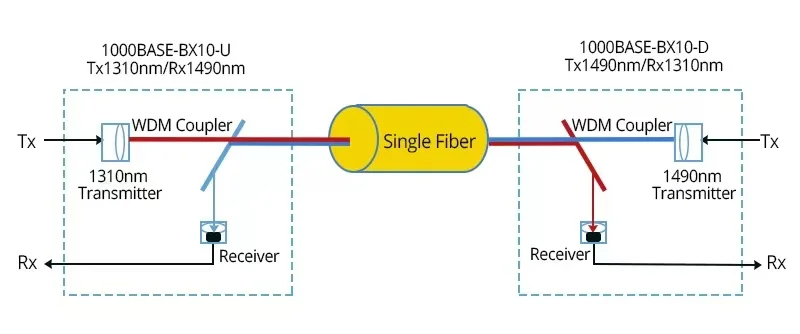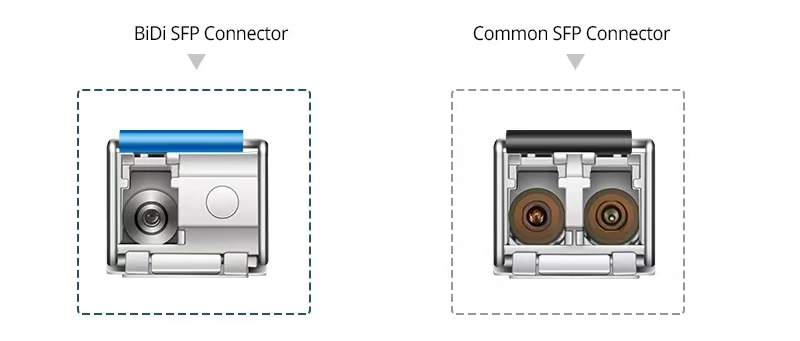Introduction About BiDi SFP and BiDi Fiber
Single-fiber BiDi SFP optics play an important role in saving fiber resources in fiber optic communication. This post will give a comprehensive and detailed analysis of BiDi SFP transceivers including BiDi optics wiki, working principle, adopted technology, fiber cable connection solution, application, and differences compared with common SFP in detail.
What is BiDi SFP?
BiDi SFP means bidirectional small form-factor pluggable transceiver. The most distinct characteristic of the bidirectional SFP transceiver is that it is able to achieve bidirectional fiber optic communication by operating on a single fiber. Based on WDM (Wavelength-Division Multiplexing) technology, BiDi optics are able to split different wavelengths of light paths through an integrated wavelength-division multiplexing splitter of BiDi SFP transceivers. The following is a Cisco BiDi SFP provided by QSFPTEK.
Figure 1: Cisco compatible bidirectional SFP transceiver of QSFPTEK
How Does BiDi SFP Work?
As the above-mentioned introduction about BiDi SFP, we have learned the modules separate different transmission wavelengths over a single fiber to achieve optical communication. To elaborate, the single-fiber bidirectional SFP transceivers must be used in pairs, as depicted in figure 2. At one side a 1000BASE-BX10-U (Tx1310nm/Rx1490nm) BiDi SFP transceiver transmit a 1310nm wavelength optical signal and receive a 1490nm optical signal while the opposite side of the single-fiber bidirectional link 1000BASE-BX10-D (Tx1490nm/Rx1310nm) BiDi SFP transmit a wavelength of 1490nm and receive a 1310nm optical signal conversely. The integrated optical component of WDM couplers plays a critical role in bidirectional fiber optic communication.

Figure 2: Working Diagram of BiDi SFP
BiDi Fiber Selection
Single fiber or Dual Fiber
Different from the common SFP transceivers, which are typically designed with two ports, one for transmitting signals and the other one for receiving signals, BiDi SFP has only one port for both transmitting and receiving based on WDM technology. Consequently, BiDi SFP uses only one single fiber while the common SFP optical transceivers need duplex fiber to achieve fiber optic communication.

Figure 3: Single fiber BiDi SFP or Dual Fiber
Single-mode Fiber or Multimode Fiber
Generally, BiDi SFP is designed to support link lengths of 10km to 120km. For fiber optic cable, the signal is transmitted as a light impulse in the fiber and bounces off the fiber cladding. Signals will be partly lost during the bouncing process. The smaller core is able to minimize this bouncing signal loss and allows a longer transmission distance, so single-mode fiber is typically used in BiDi optics links for its smaller diameter core of 9um compared with 50um of multimode fiber (OM2).
However, whether the existing multimode fiber used in the short-range distance connections can be used to connect BiDi transceivers? The answer is yes. QSFPTEK lab has carried out a few tests to confirm it by using a pair of 1310nm/1550nm BiDi SFP transceivers. The testing result shows they operated well within 320m transmission distance via multimode OM2 cable but ended up with bit failure rates in the longer distance. Consequently, BiDi SFP can be used in multimode fiber connections, but it is suggested that the transmission distance should be no more than 300 meters.

Figure 4: 1000BASE-BX-U BiDi SFP connects 1000BASE-BX-D over a single fiber
Related products used in the above singer-fiber BiDi connectivity
Cisco Compatible 1000BASE-BX SFP TX1310nm/RX1490nm 20km Transceiver Module
Cisco Compatible 1000BASE-BX SFP TX1490nm/RX1310nm 20km Transceiver Module
LC UPC to LC UPC Simplex OS2 Single Fiber Optic Cable
Why Do We Need BiDi SFP - Applications
BiDi SFP optics allow bidirectional fiber optic communication over a single fiber, thus a number of fiber resources and cabling construction costs are saved to a great extent. They have been widely used in PTN (Packet Transport Network) network deployment. The application of the transceiver can be concluded as follows.
Network Link Capacity Expanding - When network operators build transmission networks, the scale of optical cables is deployed according to a certain business volume and fiber core ratio. However, with the continuously increasing number of users in recent years, there is a gradual shortage of optical cable core resources. If reconstructing new optical fibers, it will take a long construction cycle and enormous costs. Then this problem can be effectively solved by using the single fiber BiDi transceivers, realizing the rapid improvement of the capacity of network links and saving the cost of network construction in the meantime.
Network Link Maintenance - When the optical fiber cable link is interrupted unexpectedly in the single-fiber bidirectional transmission system, the maintenance and repair time will be greatly shortened, because compared with the traditional dual fiber transmission system, the number of optical fibers requiring maintenance and repair is reduced by half.
What are the Differences Between BiDi SFP and Common SFP
After the previous elaborate introduction about bidirectional meaning, how BiDi optics work, BiDi fiber, and applications, the differences between BiDi SFP optics and Common dual-fiber SFP optics can be concluded as follows.
Outline Appearance - Single-fiber BiDi SFP connector has only one port whereas common SFP has two ports.
Matching Fiber - BiDi SFP allows only a single fiber to achieve bidirectional fiber optic communication whereas Common SFP needs two fibers.
Internal Optical Structure and Working Principle - BiDi SFP adopts WDM technology and integrates a WDM coupler to combine and separate different wavelengths over the same single fiber whereas common SFP doesn’t.
Usage Method - BiDi SFP must be used in pairs while common SFP needn’t. For example, 1000BASE-BX-U (Tx1310nm/Rx1490nm) BiDi SFP must operate with 1000BASE-BX-D (Tx1490nm/Rx1310nm) BiDi SFP.
Wavelength Distinction - All of the BiDi SFPs are characteristic with only single-mode wavelengths whereas common SFPs have both multimode wavelengths ( such as 1000BASE-SX 850nm transceiver )and single-mode wavelengths (such as 1000BASE-LX/LH 1310nm transceiver).

Figure 5: BiDi SFP Connector vs Common SFP Connector
QSFPTEK provides sufficient BiDi transceivers and fibers from 1.25 Gbic BiDi SFP to 40G BiDi QSFP at the best price, welcome to consult via sales@qsfptek.com.
QSFPTEK 1.25 Gbic BiDi SFP price list:
| BiDi SFP Transceiver Description |
Price |
| $ 6.9 |
|
| $ 6.9 |
|
| $ 8.9 |
|
| $ 8.9 |
|
| $ 12.9 |
|
| $ 12.9 |
|
| $ 29.9 |
|
| $ 29.9 |
|
| $ 39.9 |
|
| $ 39.9 |
Related Articles:
QSFP-40G-SR-BD VS QSFP-40G-SR4
Bidirectional (BiDi) Transceiver Technology, The Most Effective Method to Improve Fiber Utilization










